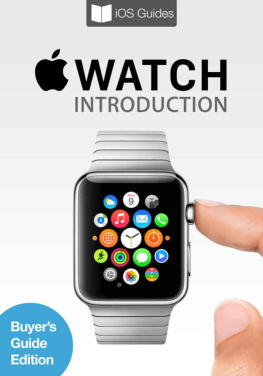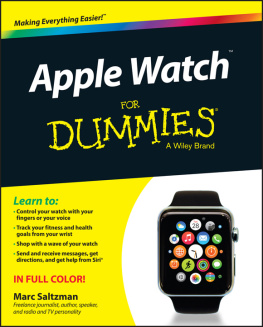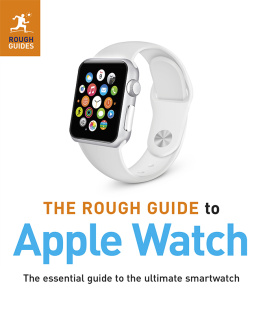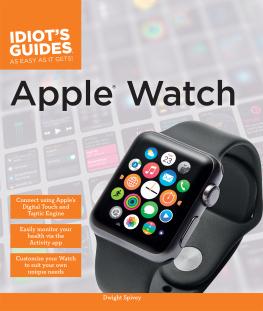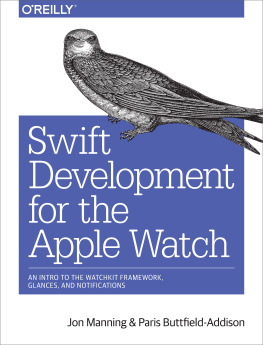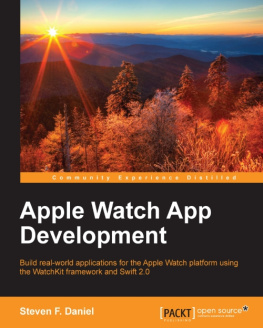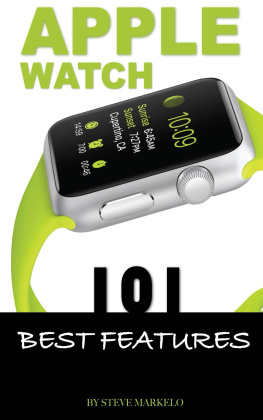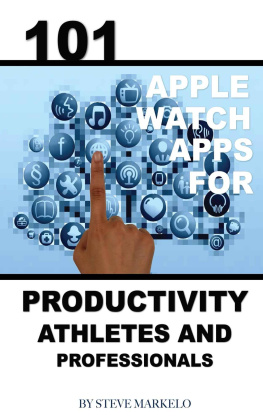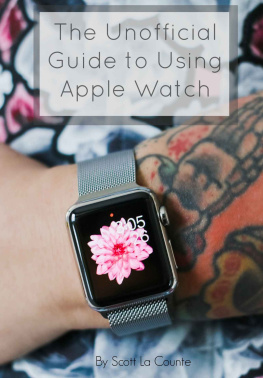Apple Watch Introduction 
Apple has been making electronic devices for nearly 40 years. Chances are youve owned a few of them. From computers and mice, to audio players and tablets, theres a staggering breadth of product variety in Apples portfolio. In 2015, the company launched the Apple Watch. Its a brand new category of device for the company, and it brings with it a number of unique challenges that meant rethinking how hardware and software interact with the user. Apple Watch needs to be light and comfortable, but sturdy enough to survive everyday wear and tear. It needs fit snugly on a number of wrist sizes, and work for both right and left-handed users. It needs to be splash proof, and work in both hot and cold climates. It needs to charge wirelessly, and have enough battery to make it through the day, and it needs to be personal, and beautiful, and easy to use. Thats a lot to ask for a device thats mere inches in size.
Smart watches have been with us for quite some time. During the 1970s, Pulsar and Hewlett Packard introduced watches with built-in calculators, while recently a number of companies including Samsung and Sony have released watches that integrate with mobile phones to alert users of notifications, give directions and even take photos. Apple Watch is the first to make technology more accessible, relevant and personal. It melds technology with fashion to create a device that youll actually want to wear on your wrist, and one that compliments your attire, whether thats a suit, dress, jeans or beach wear.
There are three models of Apple Watch, one made from aluminium, another from stainless steel and a third made from 18-karat solid gold. These are available in two sizes, work on either your left or right wrist, and come with various straps and bands that can be swapped at will. All these variations make Apple Watch the most personal device in Apples history.
Apple Watch is an incredibly precise timepiece. It uses multiple technologies to keep time down to 50 milliseconds of the definitive global time standard, and as you travel the globe it automatically adjusts to the local time zone. Apple Watch also presents time in a more meaningful, personal way by notifying you of alerts and events relevant to your lifestyle. Its also an intimate device. Using sensors on the ceramic back plate, it can sense your skin contact and read your heartbeat; and when a notification comes through, it gently taps your wrist to let you know.
Apple Watch is designed to keep you fit and healthy, and it can give you a complete picture of your days activity by measuring the movements you take, steps you climb and calories you burn. By using the built-in Activity app, you can get an at-a-glance view of your fitness progress. Three colored rings tell you to sit less, move more and exercise, and over time Apple Watch will learn about your daily activity to offer personalized fitness goals.
Just like the iPhone, iPad and Mac, Apple Watch supports third-party apps that offer limitless potential. At launch there are dozens to choose from, including an app that monitors the charge of the electric BMW i3, an app that helps you board a plane, apps for finding hotels, staying up to date with social media networks and much more. Theres a bright future ahead for Apple Watch. It represents a new chapter in the relationship that people have with technology, and will likely introduce new possibilities that affect how we communicate with others, monitor our health and organise our lives. This book will explore the hardware and software of Apple Watch, explain the differences between the three versions and reveal how to use its many features and apps.
Apple Watch Hardware
From its inception and initial design, Apple has designed Apple Watch with a deep reverence and respect for the art of fine watchmaking. Its raw materials were chosen to honour the traditions of the best, but also push boundaries and improve upon the past. That means custom gold alloys were used for Apple Watch Edition, to create a case thats twice as hard as standard gold. A single sapphire crystal is used to protect the flexible Retina display, and a custom aluminium alloy was created for Apple Watch sports thats 60% stronger than standard aluminium. This care and attention is reflected in all aspects of Apple Watch, including its screen, Digital Crown, bands and straps.
Gold
Apple Watch Edition is a beautiful, timeless device with a case made from 18-karat gold. Gold is naturally a soft material, which makes it perfect for coating or crafting beautiful objects, but leaves it susceptible to nicks and scratches; which is why the metallurgists at Apple developed a new hardening process that makes the gold used for Apple Watch Edition twice as hard as standard gold. Additionally, precise adjustments in the amount of silver, copper and palladium used in the alloy of the gold enable Apple to offer Apple Watch Edition in both gold and rose gold colors.
Stainless Steel
Stainless steel has long been used for fine watchmaking. Its renowned for its durability and corrosion resistance, which makes it the perfect material for a device thats worn all day long. Apple takes stainless steel, then uses a specialized cold-forging process to make it 80 percent harder, which helps to prevent nicks and scratches from reducing the allure of Apple Watch. This same stainless steel is also used for the closures that enable Apple Watch to fit so precisely. As for the Space Black Apple Watch, Apple adds a diamond-like carbon layer to create a unique and durable finish.
Aluminium
Apple uses 7000 series aluminium for Apple Watch. Thats the same used in lightweight competition bikes. But to make it even stronger and durable, Apple altered it to create a brand new alloy thats just as light, but 60 percent stronger, and one third the density of stainless steel. To create the textured finish that reduces reflections, each case is machined and polished before being blasted with microscopic zirconia beads. A special anodising process then creates a hard, clear outer layer to protect against scratches and corrosion.
Sapphire Screen
Sapphire is the second-hardest transparent material after diamond, which makes it the perfect substance to cover the faces of Apple Watch and Apple Watch Edition. A single crystal of sapphire is used to make the display, and its cut with a diamond-encrusted wire to ensure a precise fit for the case. Afterwards, diamond-covered pellets are used to polish and finish the screen, making for a beautiful reflective surface.
Ion-X Glass
Ion-X glass is five times stronger than standard glass. Its made by dipping the glass in a 750 F molten potassium salt bath. An ionizing process then takes place where the smaller sodium ions are removed from the glass and replaced by larger potassium ions. This hardness and resistance to scratches meant it was used in the space shuttle, and is still used today in the windows of high-speed trains. Now, its being used to protect the flexible Retina display on Apple Watch Sport.
Zirconia
The back surface of Apple Watch needs to be non-conductive, and also opaque to eliminate crosstalk between the components of the heart rate sensor. Thats why zirconia was chosen as the material of choice. Its a ceramic material that undergoes a heating process of 2,640 F, which lasts for more than 30 hours; then during the cooling process, the sapphire lenses for the sensors are added. Finally, a grinding stone is used to create a smooth finish that feels comfortable against the skin.

